Story of the
2012 Panama Canal
Trip, Part
Three (the conclusion)
Written by Rick Archer
February 2012
|
|
|
|
Marla and I got up at
4:30 AM in order to get a front row seat to see the Panama Canal.
This would be the day
when I would be forced to confront my views on the propriety of
"saving seats". I wanted to save two spots for Shari and
Polly.
|
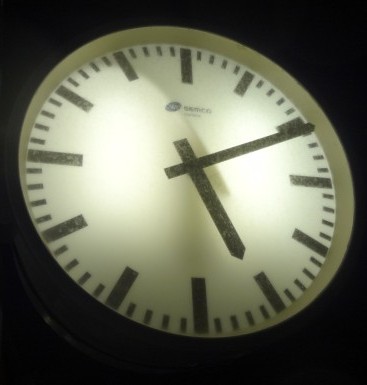 |
Actually, let me be more
specific. In particular I wanted to save a spot for Polly. I
knew Shari would be able to fend for herself.
I figured the easiest
way to assure myself of getting a spot for Polly would be get there
early and annex a
corner of the front deck for myself.
Employing an age-old
tactic known as "the early bird gets the corner seat", I was on deck
shortly after 5 AM.
This would turn out to
be one of longest days of my life in several ways.
|
|
 |
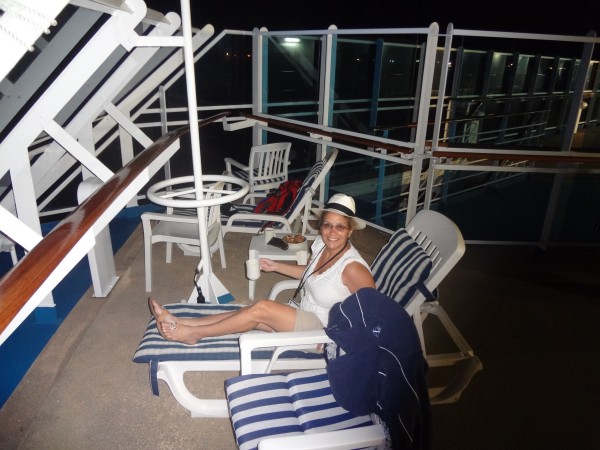 |
When I first arrived, there
was not a single chair available on this deck. Consequently I
went to mid-ship and found plenty of available seating. One at a time, I
carried two lounge chairs and two deck chairs over to Rick's Corner
on the front deck.
After establishing my
turf, I let Marla hold the spot while I went to fetch us some coffee
and bran muffins for a simple breakfast.
Upon my return, Marla
seemed grumpy about something. When asked, she said that two
different men had come over and tried to take the chairs that
weren't being used.
At that, Marla left to go run a
chore. There I was all alone at 5:30 in the morning. After she
left, I thought that was
really strange. Why would they want OUR chairs when there was
an entire ship full of chairs?
I would soon get my
answer. As it turned out, the presence of three empty chairs
on a deck that had no other chairs at all was simply irresistible.
Why go to mid-ship to find a chair like I did when all they had to
do was take one of our chairs?
Surely those chairs were
there just for them!
|
Just as I was thinking about it, a man came over and
asked to sit in one of the chairs. I said I preferred he
didn't. I wanted to be alone. "Well, can I take one of these
chairs for myself?"
Irritated, I said yes. I watched with frustration as he walked away
with one of my chairs. Then I went back to mid-ship and got a
replacement. My mistake was not getting two instead.
Shortly after I
returned, another man showed up. He was about 70. I was
incredulous when he walked right in front of the chair I was in.
My jaw dropped in consternation. Here was an entire empty
deck, but this guy came and stood in front of me.
Then he turned around
and looked to sit in one of the chairs. I politely said those
chairs were reserved for my family. I added I would appreciate
it if he would sit elsewhere.
He replied, "I think I
will just go ahead and sit here till they show up."
I stared at him
incredulously. I immediately had a flashback to Shari's
dolphin thief. This was the exact same attitude.
|
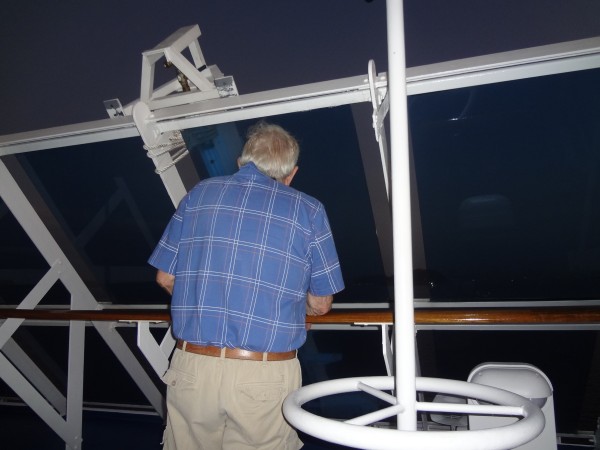 |
"Sir, I brought these
chairs over here for my own use. This spot is mine. There is an entire ship and a thousand other
chairs at your disposal. You may have this extra chair if you
insist, but please do not sit here."
"You can't tell me what
to do. I'll sit here if I want to."
I stood up and blocked
his path.
"Actually, I can tell
you what to do. I am telling you that you are not welcome to
sit here." I grabbed one of the
chairs and handed it to him. "Take this chair. Now go sit somewhere else."
"You are something else,
buddy. You are a f----g A-hole!"
"Maybe so, but you
have no business talking to me that way. Now get lost and
find someplace else to sit."
He indeed left, but I
saw him throw the chair away and leave the area.
I was really angry. This had been a very ugly encounter... and
a highly unnecessary one as well.
It was only 6 AM and this day had gotten off to a lousy
start.
|
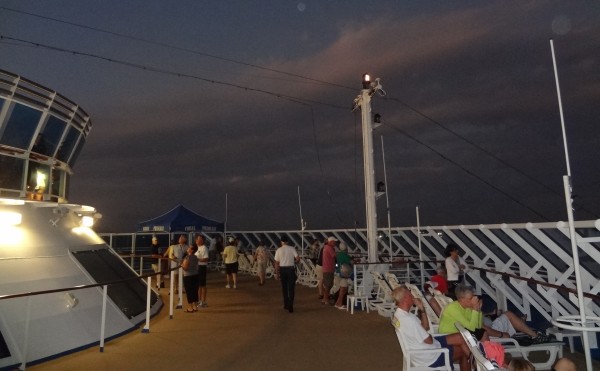 |
Marla returned and I
explained what had happened. She didn't say anything, but I
don't think she approved of my role in this confrontation. Her
lack of support made questioning my behavior even more
difficult. As I went to fetch the missing chair back, I was now in a very bad mood.
It took me a long time to snap out of it.
There were no further
incidents. Other passengers began showing up. They
found chairs of their own with no difficulty.
I suppose if I had to do
it all over again, I would bring up six chairs and put out two for
people who just wanted to sit for a moment. That's a trick I
would use later in the day to good effect. Unfortunately, as
always, my good ideas came to me well after they could have been of
use.
As I sat there mulling
the incident, I told myself I could never have anticipated the fatal
attraction of my three unoccupied seats on a deserted deck in the
dark of night at 6 am.
|
These three islands are
Flamenco (nearest), Naos, and Perico. Ancon is that large hill
further in the distance.
Ancon served as
headquarters during the American effort to build the canal.
I might add there are many graves on that hill. An
estimated 25,000-30,000 men (the French and American effort
combined) died, mostly from yellow fever.
Using dirt and rock
excavated from the Culebra Cut, the workers were able to build a
causeway that links these four islands to the mainland.
The cruise ships dock
next to Flamenco and tender their passengers to this small island.
Flamenco is where
the taxis and buses wait to pick them up.
In the distance, you can
see the first hint of the amazing skyline of Panama City. That
impressive skyline is a good indication of the kind of money that flows through
Panama these days.
Below is a better look
at the skyline. That weird-looking building is a Trump luxury
hotel and casino modeled on the famous Burj al Arab Hotel in Dubai.
|
 |

At 7 am, we started
rolling.
Our first landmark was
the Bridge of the Americas.
There are only three
ways for a car to get across the canal.
This bridge is one and the
Centennial Bridge up ahead is the second. 50 miles away I would
later discover a
weird drawbridge at the Gatun Locks that serves as the third
crossing.
As we approached the
bridge, the deck was now crowded. People began to surge
forward for a look.
They quickly became very frustrated.
|
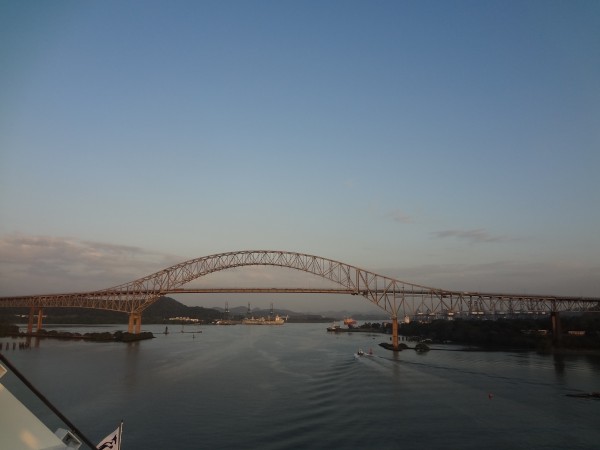 |
The problem was that the
ship had thick Plexiglas windows that reached 8 feet high. The
people who wanted to take pictures were furious. This left
only two ways to get a decent picture.
One way was to stick a
camera through that narrow slit seen in the picture. The other
was my preferred way. I would stand on my chair and photograph
over the top.
Naturally security
didn't approve, so I had to look around and make sure security
wasn't nearby to take many of my pictures.
One enterprising lady
scooted in front of me. Her name was Cindy. If you study
the glass and the lines of the metal, the glass slants back at a 60°
angle. No one could possibly stand up in the "blue area"
unless they were three feet tall.
However Cindy was able
to make it work by scrunching down. She spent a lot of time
down there taking pictures. She was quite the acrobat.
You do what you have to do.
That's my foot in the
picture. Out of the picture to my right is the much-coveted seat I was
saving for Polly.
Fortunately I had
learned my lesson and brought more chairs to share. This made it easier for
me to save my chair for Polly.
|
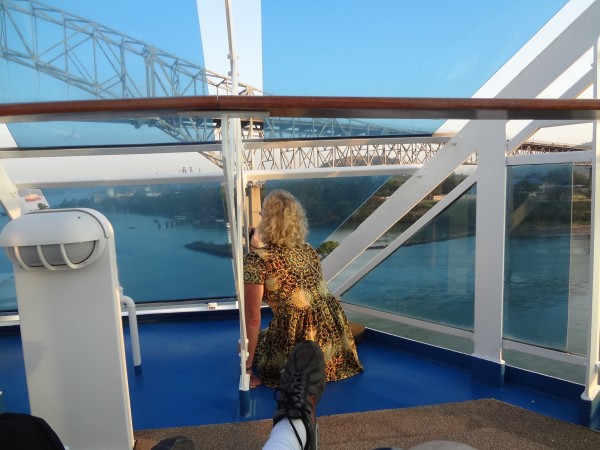 |
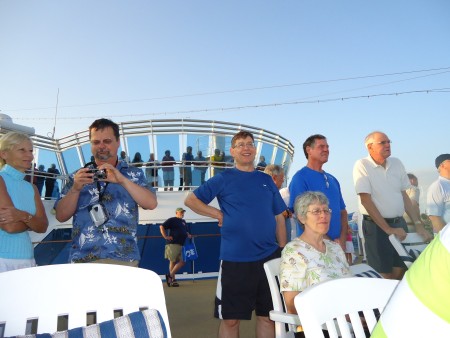 |
For example, the lady in white and
the gentleman in green are both sitting in chairs I provided.
Polly and
Shari showed up on my deck just as we reached the locks. They had
been on their balcony the entire morning waiting to get their
picture taken along with Shari's poster.
They were posing for the
videographers on the pier who filmed them as the ship slowly passed
by.
|
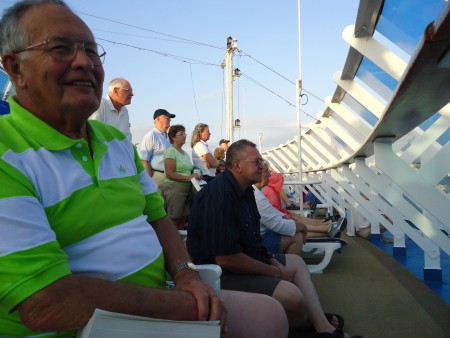 |
 |
Polly was thrilled to
find I had saved a seat for her. She now had a
comfortable front row seat in a shaded area. The tinted
Plexiglas shielded her from the sun.
I breathed a sigh of
relief. Now that the empty seat was occupied, my seat saving
ordeal was over.
Unfortunately I was so focused
on the locks I
forgot to take Polly's picture. This poster picture is the only
one I remembered to take.
|
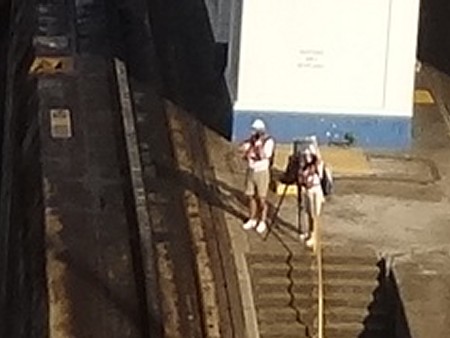 |
When Marla saw how happy
Polly was to discover that available seat, she gave me a wry smile
and a nod of her head. I had spent the entire morning
explaining to people that I was saving that chair for my mother.
Marla did not appreciate the disharmony caused by my defense of that
free chair one bit.
However once she saw the
smile on Polly's face,
she did acknowledge that maybe I had my reasons to guard the chair
so carefully after all. It was the only way Polly would have
ever been able to get a good view and sit in comfort as well.
Meanwhile Shari
succeeded getting photographed by the ship's video
team. The picture on the right is from the ship's DVD.
As it turned out, her
hard work on the poster paid off. Shari not only appeared on the ship's
"memories" DVD, but the caption said "First Place Poster".
Shari later said that the Dolphin Thief had made her twice as
determined to win the contest.
Like Marla always says,
the best revenge is living well.
|
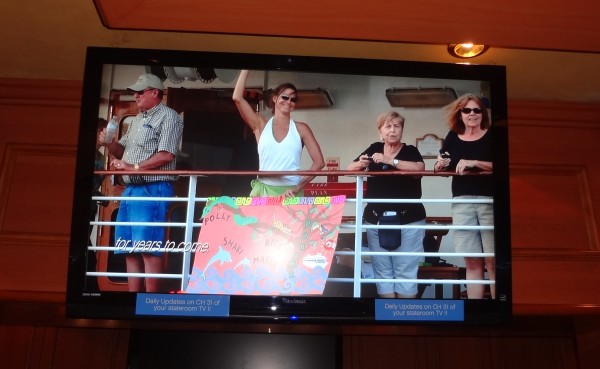 |
 |
The Panama Canal is about 50 miles long. For those of you who
are unfamiliar with how the Panama Canal works, 45 miles of the trip
is 85 feet above sea level. There are locks at both ends of the
canal designed to raise ships to canal level and lower ships to sea
level.
|
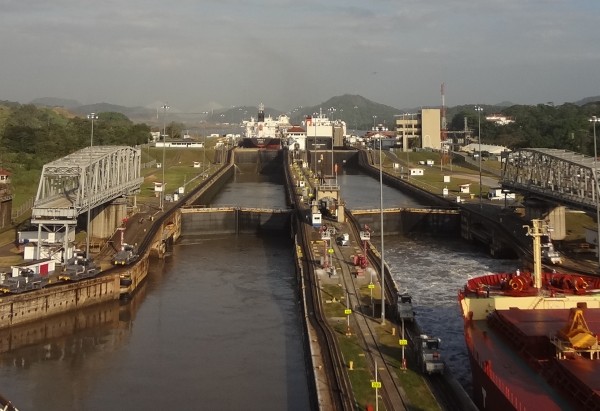 |
As we reached the first
lock known as the Miraflores Lock, you can see two ships ahead of us
that have already been raised. Miraflores Lake up ahead is about 40
feet higher than sea level.
In a minute, the gates
in front of us will open and allow our ship to enter LOCK ONE.
The ship to our right will do the same.
Then water from
Miraflores Lake will be allowed to flow into our LOCK ONE
chamber. Picture our ship as a little toy boat in a bathtub.
As the bathtub water rises, so does the toy boat.
Even though our ship
weighed over 70 tons, the water in the lake weighed oh so much more.
To the water in the lake, our ship's massive
size meant nothing. Compared to the lake water, our ship was
probably about as heavy as a
plastic boat.
Due to the water
pressure, all they have to do is let gravity push water from the
lake above down into our sealed lock and our ship will rise. If you
are interested in a more detailed explanation of
how the locks work, please visit my story.
|
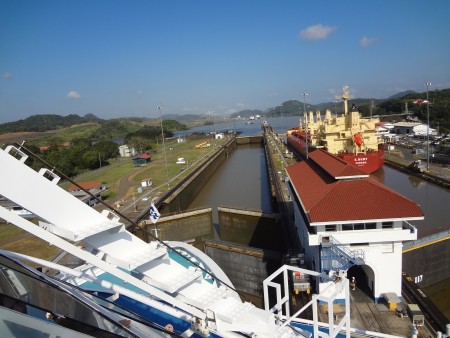
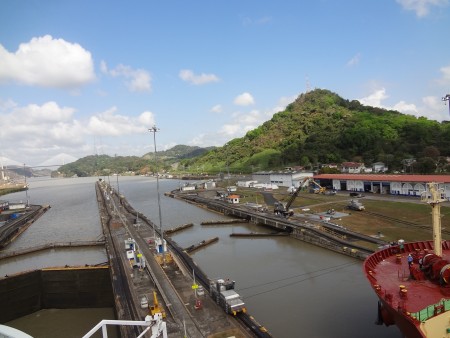 |
On the left, our ship is
currently sitting in LOCK ONE. They have just finished
equalizing the level of the waters in LOCK ONE and LOCK
TWO. The gates are opening to allow our ship to
enter LOCK TWO.
On the right, our ship
is slowly entering LOCK TWO. As you see, the lake waters up
ahead are a bit higher.
On the left, the waters
have been equalized in LOCK TWO next to us and the gates are
opening.
On the right, the
ship is preparing to enter Miraflores Lake while we watch.
The water in
LOCK TWO on our side has not been equalized yet.
Once the water in
LOCK TWO on our side has been raised, our ship will be ready to
move
forward as well.
|

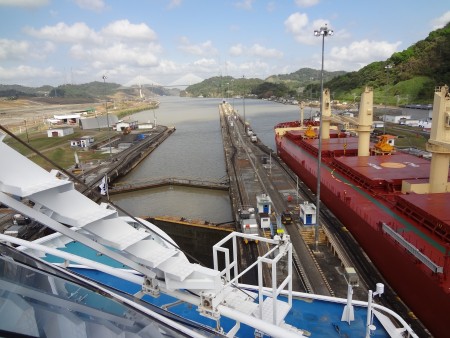 |
| |
|
|
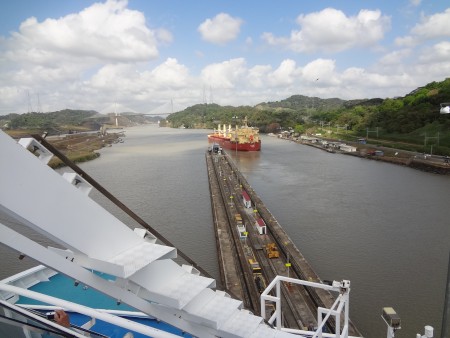 |
On the left, we have
just sailed through the third and final lock known as the Pedro
Miguel Locks.
We are now officially 85
feet above sea level. We have about 45 miles of canal in front
of us before we reach the Atlantic side.
Then we will be lowered back down to sea level.
On the right, you see
construction taking place for the newest addition to the Panama
Canal.
|
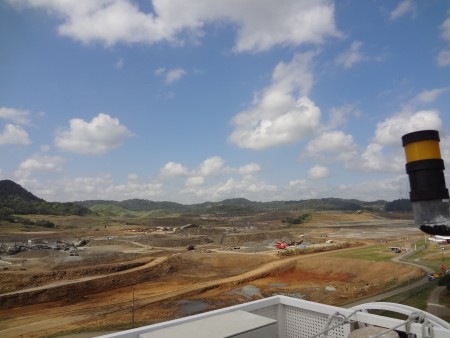 |
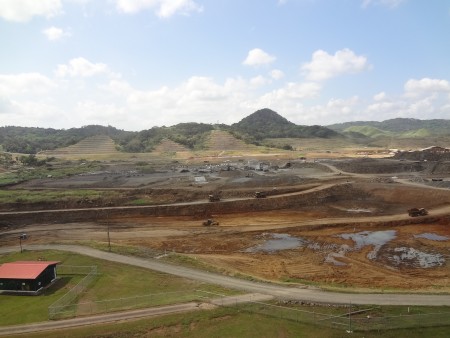 |
The Panama Canal was
first opened for business in 1914. In the 100 years since
then, modern ships have become too large to use the canal locks.
Therefore Panama is
building wider locks parallel to the old locks. They are separated by half a
mile.
These new locks will feature water retention areas to recycle.
Currently the used water escapes to the ocean.
|
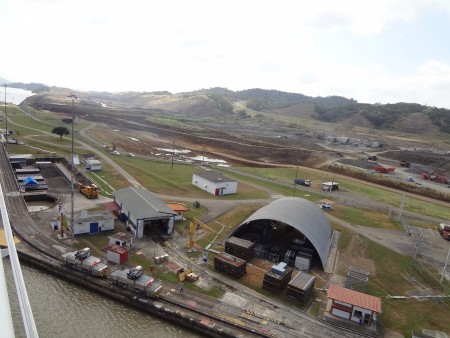 |
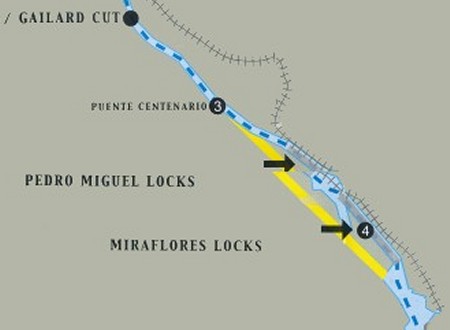 |
The yellow path on the
map shows the detour route that will allow the larger ships to
bypass the old locks.
That yellow route is
what they are currently digging in these pictures. Scheduled
to open in 2015, it looks like they have a ways to go.
Fortunately it looks
like technology has finally caught up to the task at hand.
Judging from what I saw, everything looks orderly and under control.
|
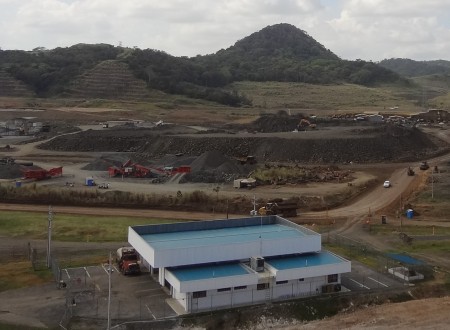 |
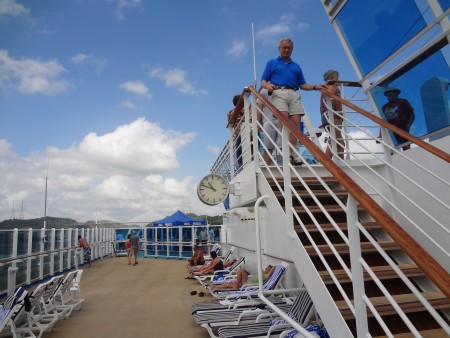 |
As we pass through the
third and final lock, it is now nearly 11 AM.
I had no idea the
process took so long. The canal saves a ship a week of travel,
so it doesn't mind being patient. However the cruise
passengers thought it got a little tedious there.
As you can see, the
crowds have thinned out. Notice the raised Plexiglas that made
viewing so difficult.
|
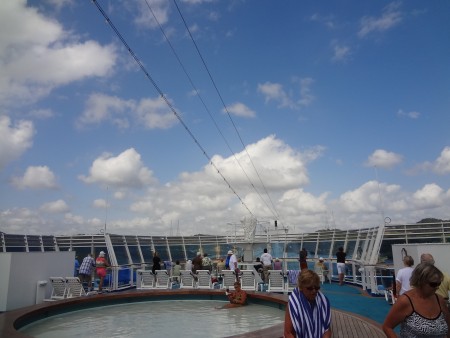 |
| |
|
|
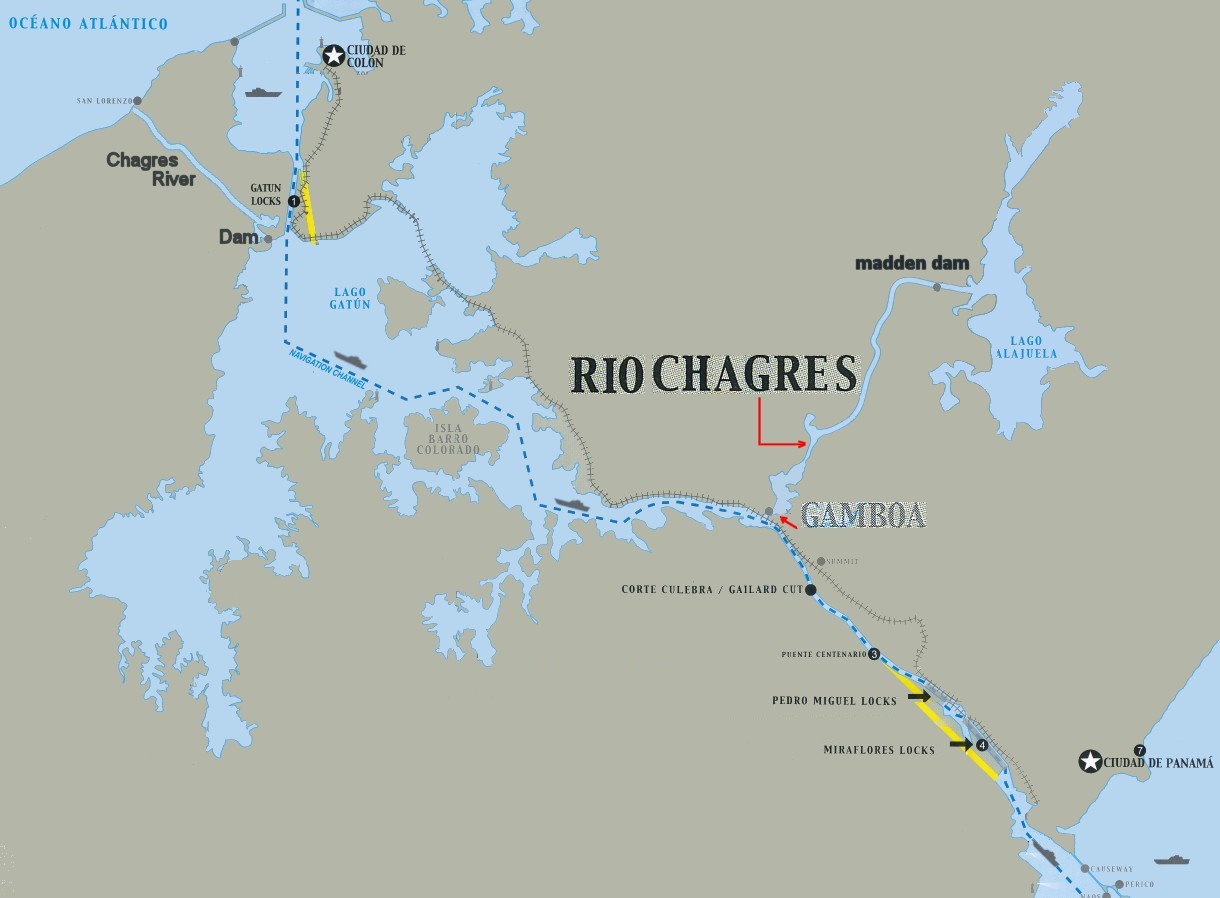 |
| |
|
|
Creating the Panama
Canal was a monumental task for two reasons. First they had to
cut a huge trench through a 500 hundred foot high hill. 500
hundred feet doesn't sound like much, but that hill was 10 miles
long. It was an incredible headache. To read more about
the struggles involved with digging the trench, click
The Big Ditch.
The second problem was
how to tame the massive river that intersected the Canal route known
as the Chagres River (Rio Chagres in Spanish). This mighty
river was forty feet above sea level. How were they going to
merge a 40 foot high river with a sea level canal? The initial plans were
to dam the river and reroute it to a brand new riverbed that ran parallel
to the canal route.
Once you see the Chagres with your own
eyes, it seems preposterous to think a river that large can be
diverted. That basically would have forced the engineers to
dig not one, but two canals... one for the ships and a second one
for the Chagres River. Doesn't sound very practical, does it?
Believe it or not,
that's exactly what the French tried to do. It didn't work. After failing on a colossal scale... 25,000 men
died and practically no real progress was made in ten years of
trying... the French gave up. When the Americans took up the
challenge, they developed an ingenious solution to the
Chagres problem. They created a lake.
Lake Gatun is a
gigantic artificial lake created by damming the Chagres near its
exit route to the Caribbean Sea. Now all they had to do
was build locks to raise ships to the level of Lake Gatun.
Truth be told, the entire project is an amazing engineering feat.
|
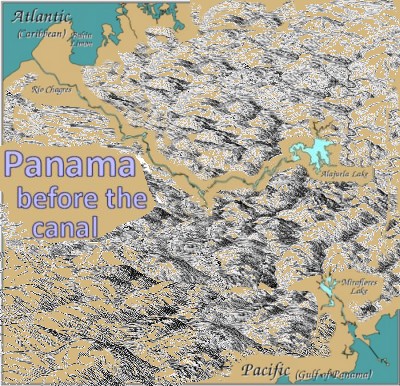 |
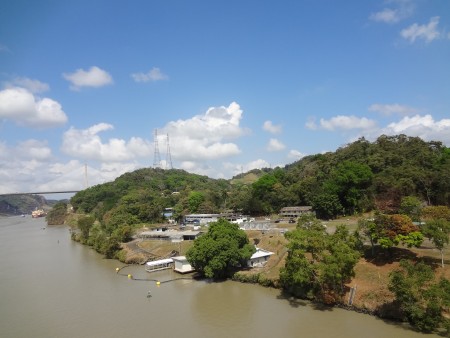 |
Our ship seemed to move
slowly through the waters, but I didn't mind. There was always
something to see.
We had a full-time
narrator named Jean who kept up a running commentary for us to
listen to outside over a loudspeaker system.
I loved listening to
her, but it drove me crazy not to be able to ask any questions!
|
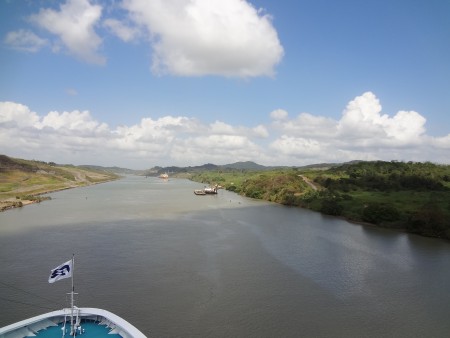 |
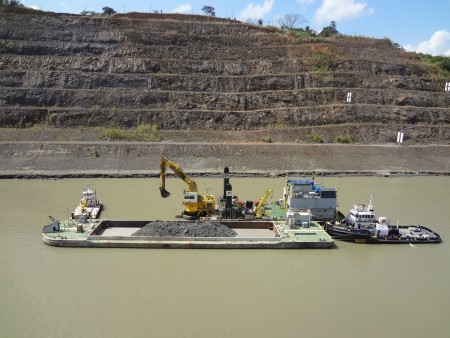 |
Jean pointed out that
keeping the channel deep enough is an on-going process.
Due to constant landslides and an
incredible amount of silt brought down during the rainy season,
dredging the canal is a year-round process. We saw many
dredging ships.
I was very curious about
that waterway being constructed on the right. I wanted to ask
Jean what its purpose is.
|
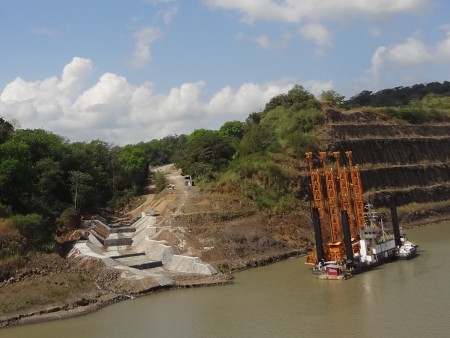 |
 |
There was construction
going on up on that hill. You can barely see, but there are
earth-movers up there clearing a large area.
The Centennial Bridge on
the right is the second major crossing of the canal. Right
beyond it is the celebrated Culebra Cut.
This bridge connects
North America to South America as a key cog in the important Pan-American Highway.
|
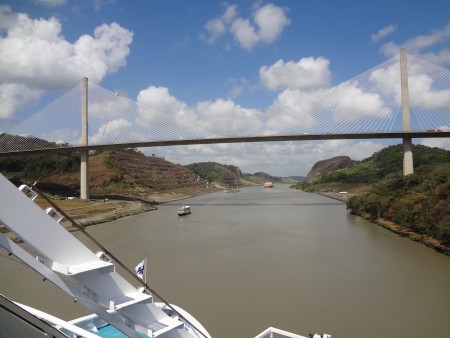 |
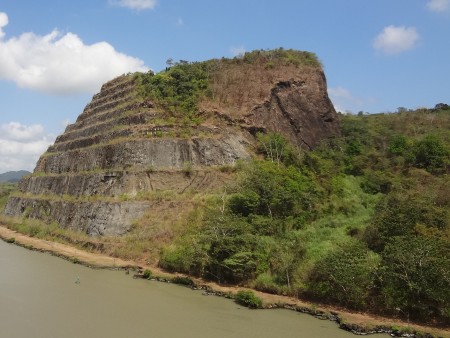 |
After the bridge, we
entered the Canal stretch known as the
Culebra Cut.
This was the area that
caused so many headaches. As they dug and dynamited, the
destabilized remaining rock & dirt were vulnerable to the constant
rains.
There was little to hold
the dirt in place, so enormous landslides created set-backs that
took not just days but many months to correct.
|
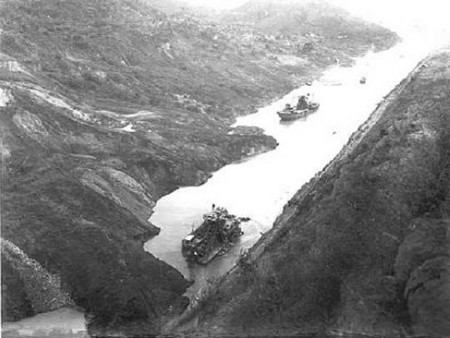 |
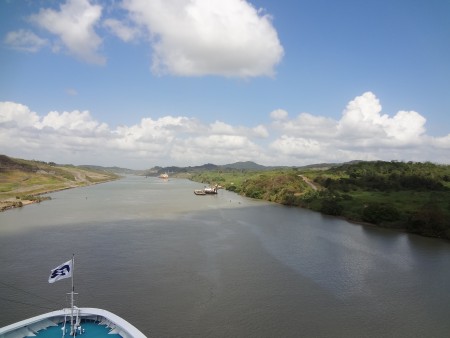 |
I was surprised to
discover the landscape immediately following the Culebra Cut was
pretty tame.
I had expected large
hills or jungle, but got rolling bluffs and plains instead.
Notice the shadows on
the water. Those overhead clouds served as my best friends all
day long. I still got sunburned, but it would have been so
much worse without the cloud cover.
|
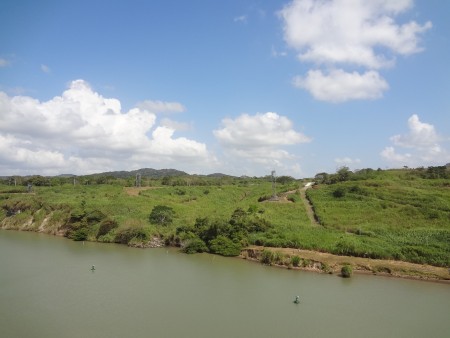 |
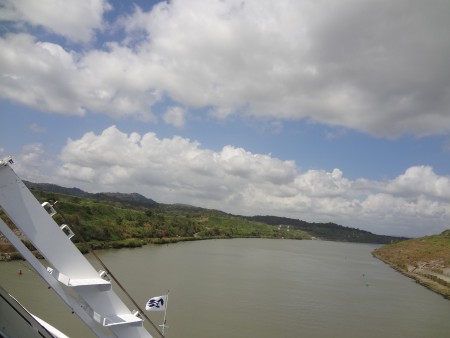 |
Just before we reached
the Chagres River, we heard music coming from the structure on the
right.
Jean the narrator said
that was a prison. I frowned. There was a little barbed
wire, but overall there wasn't much security.
This prison had just
received a famous new prisoner a couple days earlier. Some guy
named 'Noriega' had just been transferred from Miami.
|
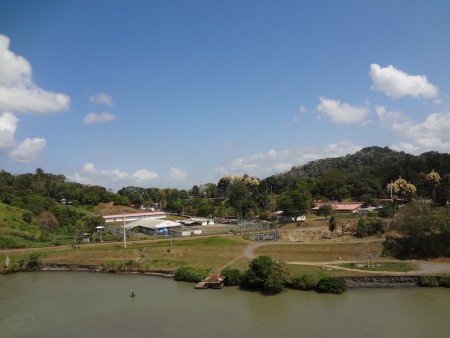 |
This is the
junction of the mighty Chagres River with the Canal
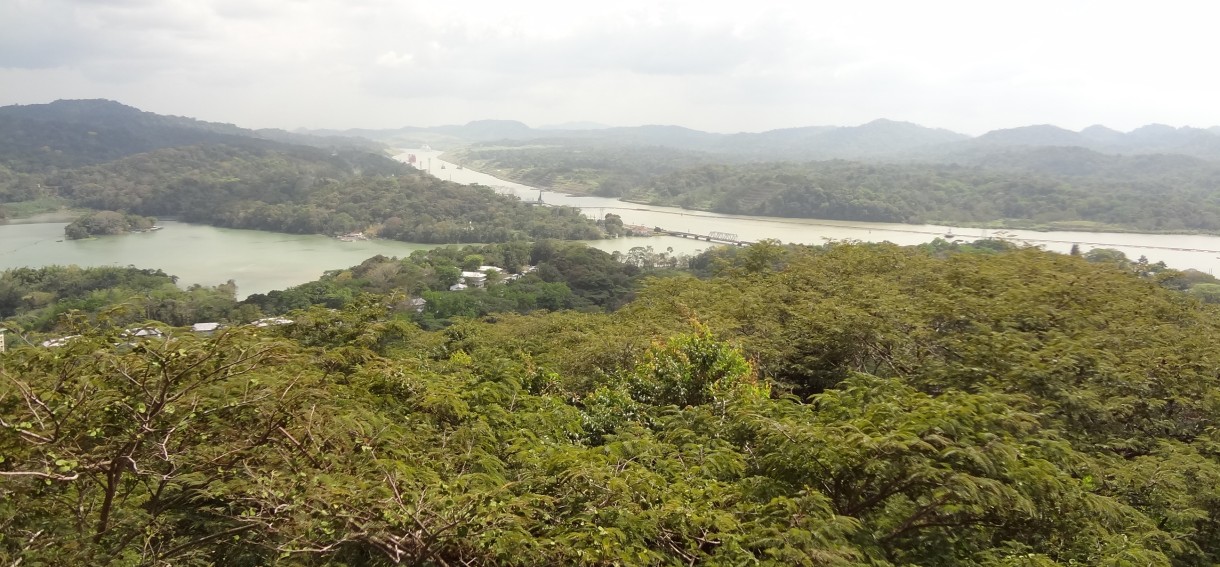
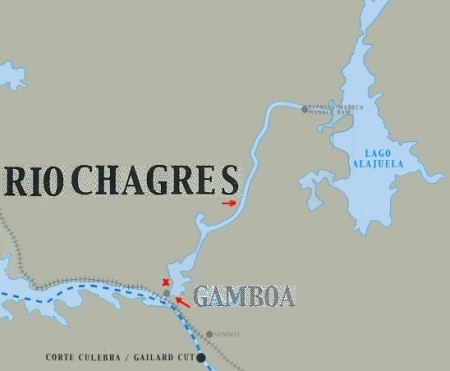 |
Here you can see the
junction of the Chagres River with the Canal from two different
perspectives.
The day before we went through the Canal, Marla and I took an
excursion to Gamboa.
Here we were able to climb an observation
deck ("X")
that allowed me to take the panoramic picture above.
I snapped the picture of
the bridge on the right from the ship as we passed by.
|
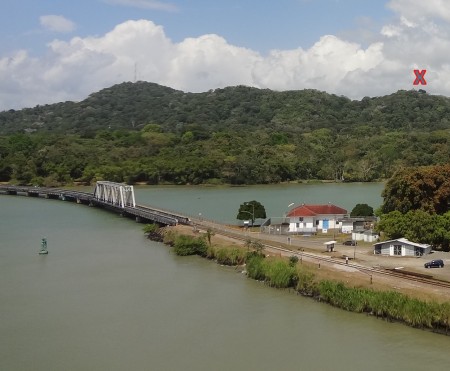 |
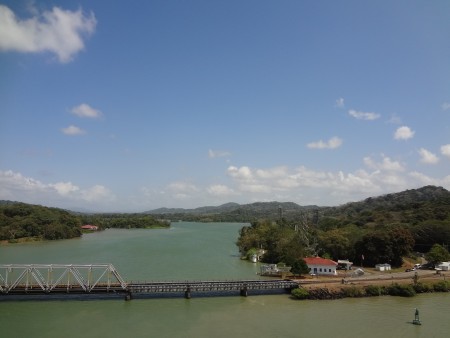 |
Note the difference in
the water color where the river converges with the muddy Canal
water.
The Chagres is the
answer to an excellent trivia question:
What is the
only river in the world that empties into
the
Pacific
and
the
Atlantic?
No picture of mine can
properly depict the size of the Chagres. To see the Chagres in
person makes the thought of taming this river seem like sheer folly.
|
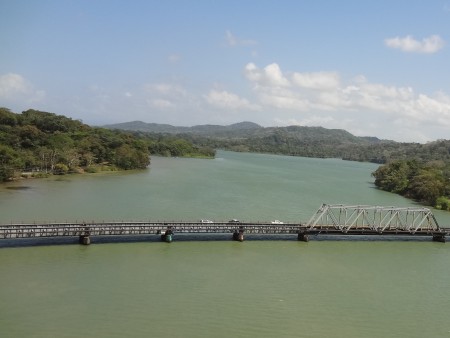 |
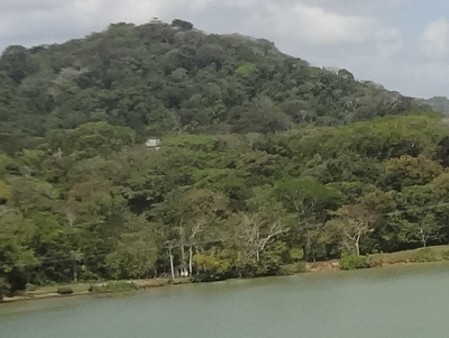 |
As we passed the
Chagres, I was shocked to spot our
X observation tower from yesterday
in the distance. Look for it atop the hill.
The little town of
Gamboa at the Canal-Chagres junction was the last sign of civilization along the
Canal route until we
reached the Gatun Locks 30 miles up ahead.
When we were in the
Culebra Cut, there was only one-way traffic.
|
 |
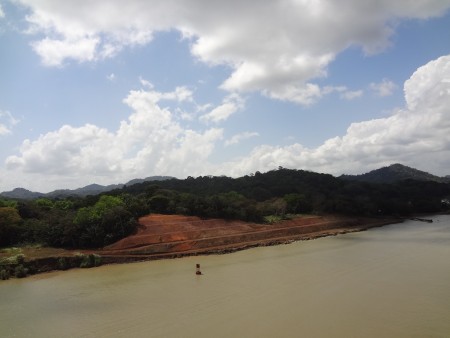 |
We were now in a two-way
part of the Canal.
When the monster ships begin to
sail, the Canal will need to get wider in many places.
This new terrace was
part of the project to widen the Canal for the coming of the larger
ships.
On the right you can see more dredging.
This Canal continues to be a work in progress.
|
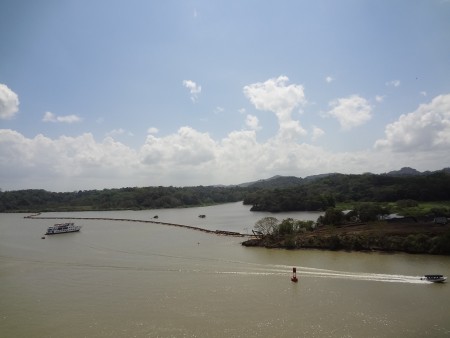 |
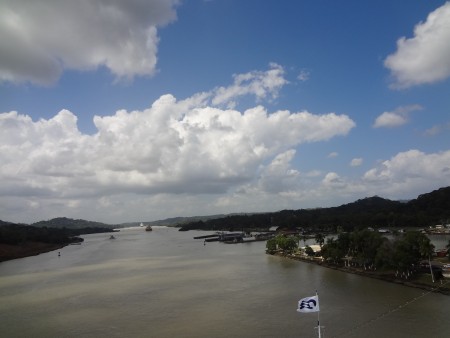 |
Just as we were passing
Gamboa, Jean came on the air to announce we would soon be meeting up with a
special guest.
There was a white ship
in the distance that sent a bolt of electricity through the crowd.
It would be another ten minutes before we reached it.
On the right, it's
coming closer.
|
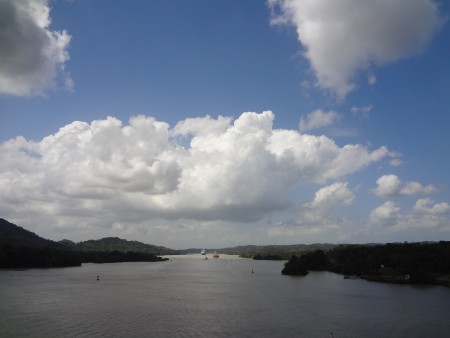 |
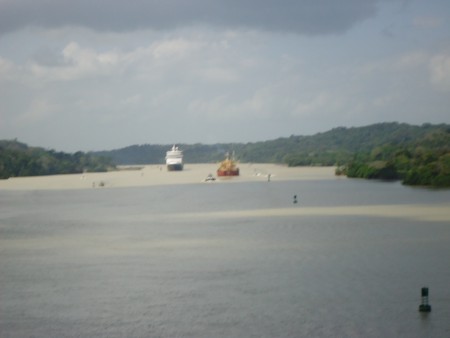 |
The mystery ship is
about to pass the orange container ship that our Coral Princess had
been following all day long.
On the right, we see the
container ship has passed the mystery ship.
There is nothing between
us now. The ship is coming into view.
What ship can it be?
It's getting closer.
And now the mystery is solved.
|
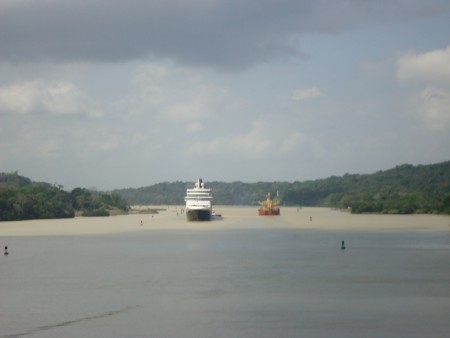 |
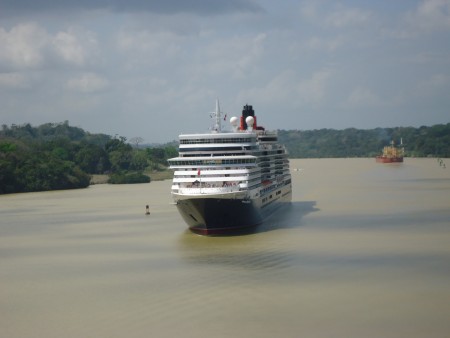 |
This is the famous
cruise ship MS Queen Elizabeth.
Jean the narrator said
she had been doing this Panama cruise for years and had never passed
a ship of this caliber before. This was an amazing
coincidence.
Jean added that our own Captain was so excited that he was going
nuts taking pictures. Jean joked that the Captain had just
turned into a tourist like the rest of us.
|
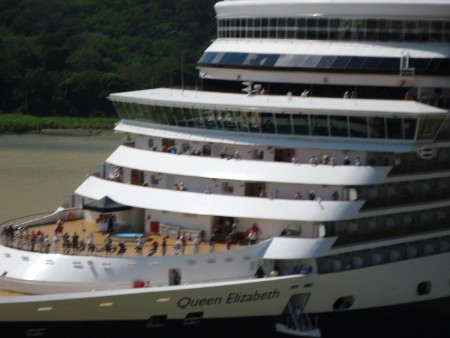 |
The Queen Elizabeth is
the second largest ship in the Cunard Cruise Line.
According to Jean our narrator, the Queen Elizabeth was on a world
cruise. Curious, I looked up the itinerary. It sounded
like something out of Jules Verne's Around the World in 80 Days.
The ship left
Southampton (England) and called at New York, Fort Lauderdale,
Aruba and Limon (Costa Rica) before transiting the
Panama Canal... which is what QE was doing at this very minute
as our two ships nearly brushed each other in the channel.
After passing us, the
Queen Elizabeth was due to sail to Acapulco and Cabo San
Lucas (Mexico) and then on to Los Angeles. After
its stop in California, the ship would cross the Pacific Ocean
to Hawaii for stops in Lahaina (Maui) and Honolulu (Oahu).
Then it was on to Apia
(Samoa) and Pago Pago (Samoa). Fiji was the final
stop before moving on to New Zealand and Australia
Thanks to Captain Cook,
New Zealand and Australia had been part of the British Empire for
centuries. The stops included Bay of Islands
(New Zealand), Auckland (New Zealand), Wellington (New
Zealand), Sydney (Australia), Melbourne (Australia),
Fremantle (Australia).
After Australia, the
next stop was Kota Kinabalu (Malaysia), and then on to
Hong Kong near the spot where her predecessor RMS Queen
Elizabeth had caught fire and capsized in 1972.
Stops in southeast Asia
would include Nha Trang (Vietnam), Ho Chi Minh City
(Vietnam), Ko Samui (Thailand), Langkawi (Malaysia),
Kuala Lumpur (Malaysia) and Penang
(Malaysia) and
Singapore, one of Marla's favorite places.
The Queen Elizabeth would then cross the
Indian Ocean westbound for Kochi (India) and Mumbai
(India). This would be followed by a
journey westbound again across the Arabian Sea to visit Muscat
(Oman) before passing
through the Strait of Hormuz to call at Dubai in the Persian Gulf.
After returning to Oman
to call at
Salalah, the ship would head to the Red Sea for a visit to Aqaba (Jordan).
From there, the ship would transit
the Suez Canal.
Along with the Panama
Canal, the Suez Canal has been given much credit for making our
world a much smaller place.
Interestingly, the Suez
Canal played a prominent role in Around the World in 80 Days.
Can you guess what other 1860s development played a similar role in
shortening the world? It too was featured in Verne's book.
Westbound Mediterranean calls would be at Athens
and Rome, then passing through the Strait of Gibraltar to
make a final call at Lisbon before returning to
Southampton.
The building of the US
Transcontinental Railroad was the other development that shortened
the trip around the world. By coincidence, Hell on Wheels is
a current TV show based on the building of the railroad immediately
following the Civil War.
So did Queen Elizabeth
make its trip in 80 days?
Nope. The world tour is expected to take 103 days. I
could not possibly be more envious. I wonder who is teaching
the dance lessons.
|
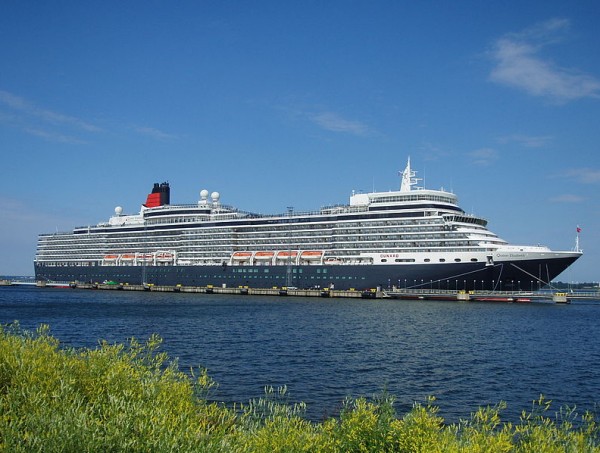 |
|
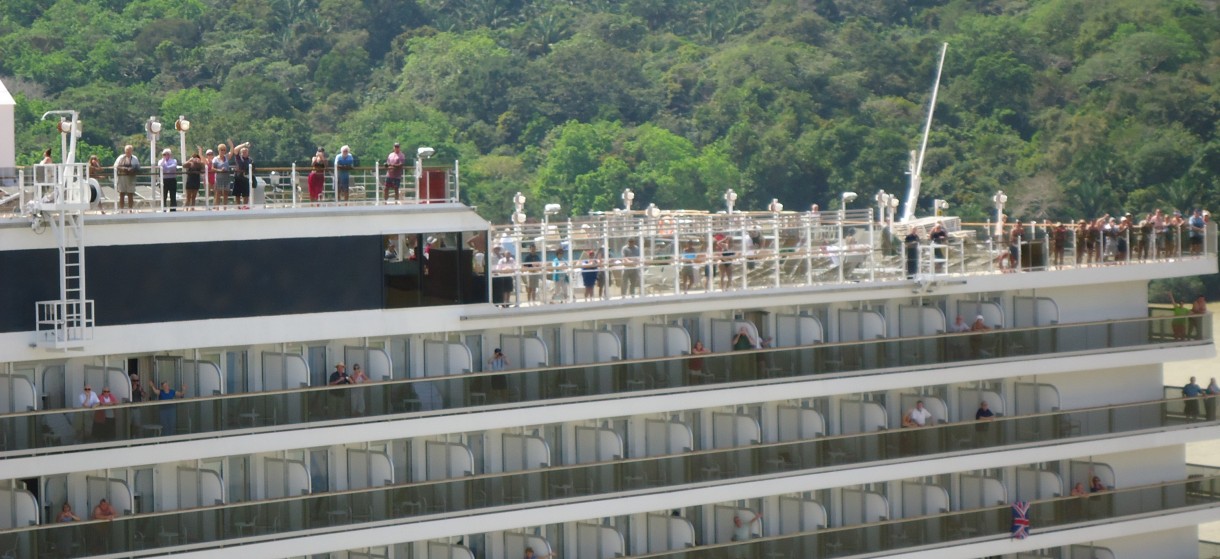 |
One person standing next to me, a Scotsman no doubt, asked aloud if
the Coral Princess had cannon aboard. "One good blast at this range
and we'll sink the bugger for sure."
However the prevailing
attitude was excitement and friendship. All of us got a kick
out of our common bond of cruising at sea and at meeting in such an
unlikely place.
I think the passengers aboard the Queen Elizabeth were just as
excited to see us as we were them. After all the time spent
dining with the UK citizens, I knew just what to say. I got a
bunch of us to cry out "God Save the Queen" on the count of 3.
We were so close I know they could hear us. I could hear laughter in response.
Just then, the Queen Elizabeth gave a
very loud long honk of its horn in greeting. The Coral Princess
responded with two short honks. The Elizabeth repeated with a
long honk; the Princess returned to short honks.
Marla turned to look at
me and laughed. She said, "Look, Rick, the ships are dancing. They just tooted
Slow Quick Quick two times in a row!"
|
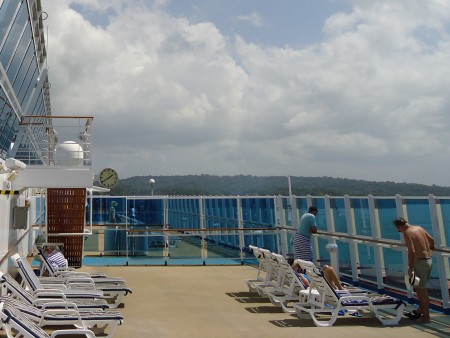 |
We passed the Queen
Elizabeth shortly after 1 PM.
I think that highlight
plus the fact that it was lunch time took the wind out of our sails.
The decks became largely deserted... except for me of course.
Sad to say, but Barro
Colorado, the huge nature preserve island at the entrance to Lake Gatun,
was a big let-down. It was all jungle and
looked like every other
place we had passed.
|
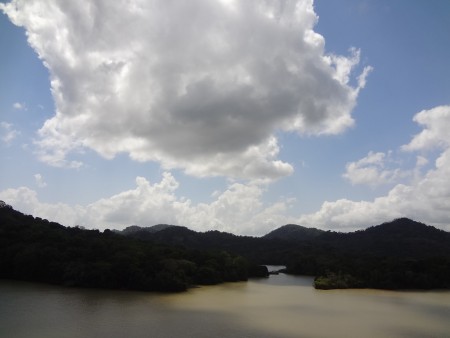 |
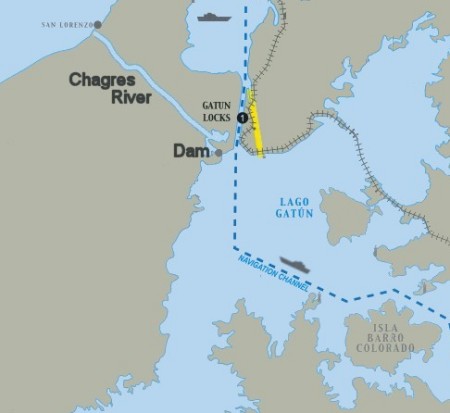 |
After Barro Colorado
Island, we entered the vast Lake Gatun. It was huge!!
Gatun was the artificial
lake created in 1908 by damming the Chagres River about 7 miles
before it emptied into the Caribbean Sea.
Now that the Chagres
waters had no place to go, over a period of two years the dammed up
waters of the Chagres slowly rose in this massive valley just like
filling up a bath tub.
Farms, villages,
forests, and even parts of the Old Panama Railroad
became submerged.
|
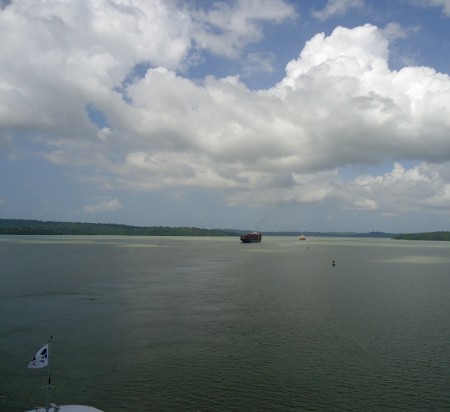 |
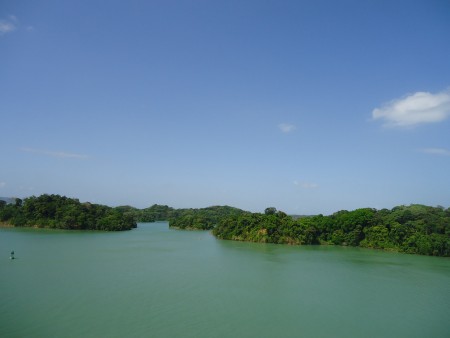 |
These little islands
were once the peaks of very large hills. During the slow
two year flooding process, the animals of the valley had plenty of
time to find new homes on higher ground.
Eventually the
animals found themselves trapped on these little islets unless they
were able to swim.
The predators soon died off because these
small islands didn't have enough animals to support their diet.
|
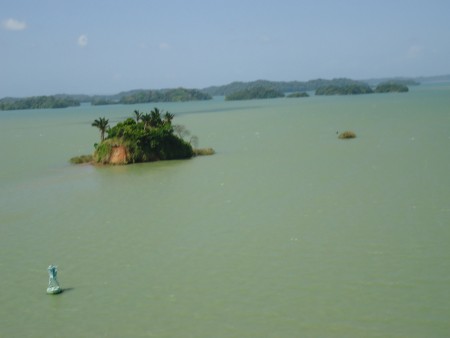 |
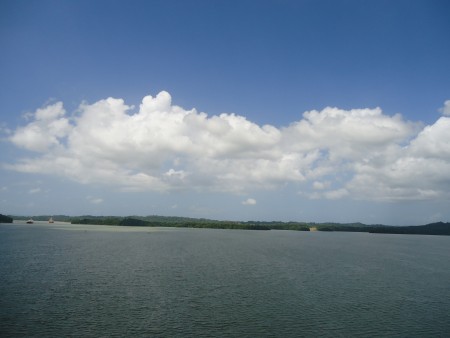 |
The fact that the
valley was so big led people to wonder what had caused such a large
depression in the first place. After all, most lakes this big
were caused by retreating glaciers. No glaciers here. Theories abounded.
My favorite theory was that a meteor crash created the valley.
The formation of this lake tamed the mighty Chagres once &
for all. These days, the major purpose of the Chagres is to
replenish the water that runs out to sea from the daily lock use.
|
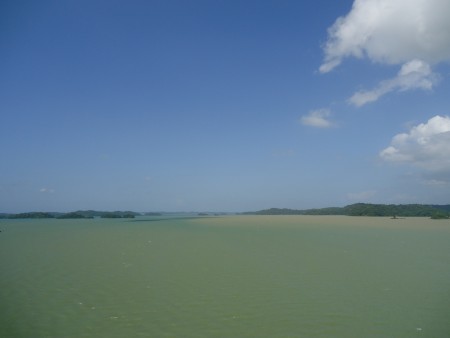 |
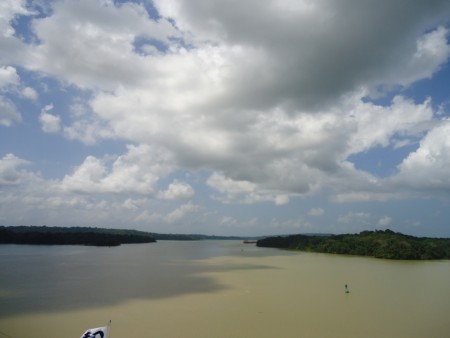 |
Back in the old days,
when the Chagres River flooded during the rainy season, people
would run in panic for safety and high ground.
Today even the strongest rainfall only
raises the water level
in Lake Gatun an inch. If the waters rise too high, they
simply spill over the edge of the dam & run out to the Caribbean Sea.
And that is how the engineers
solved the dilemma of the Chagres.
|
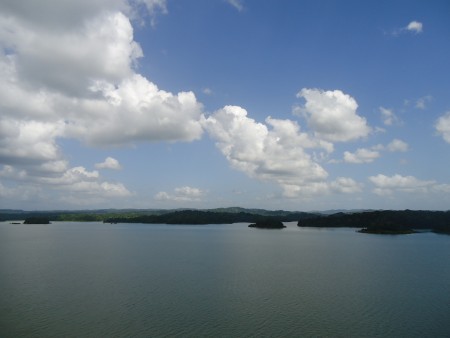 |
 |
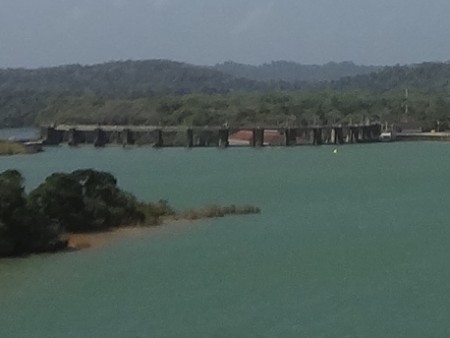 |
Finally I spotted what I
was looking for - the Gatun Dam. This was the dam that turned
the beast called Chagres into a little lamb.
Taking rock and dirt
from the Culebra Cut, they used it to create a giant earthen dam.
In turn the dam created a lake 85 feet high. Ironically, this
lake covered up over half the work the French had done. Much of
their work had gone towards creating the bypass for the Chagres.
This lake made all that work unnecessary.
|
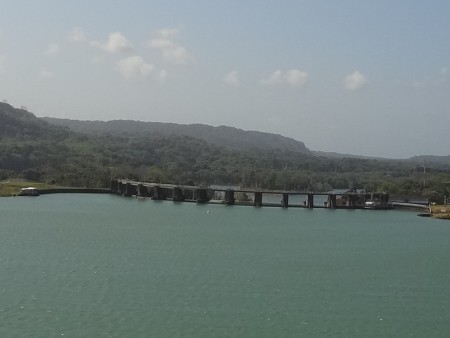 |
What was interesting to
me about the dam was seeing that the water level of Lake Gatun and
the dam were identical.
The water level would
always stay at 85 feet. If the water rose, it would simply
spill over the top of the dam. The threat of the Chagres
floods affecting the Canal was completely annihilated.
It was a truly ingenious
solution to a problem the French had never been able to solve.
|
 |
|
|
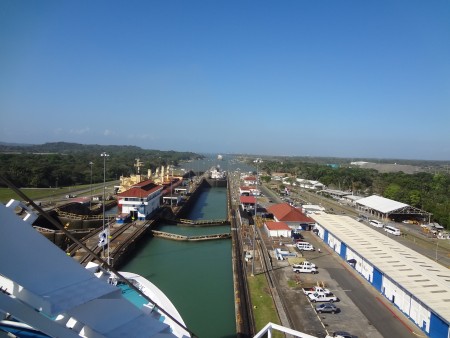
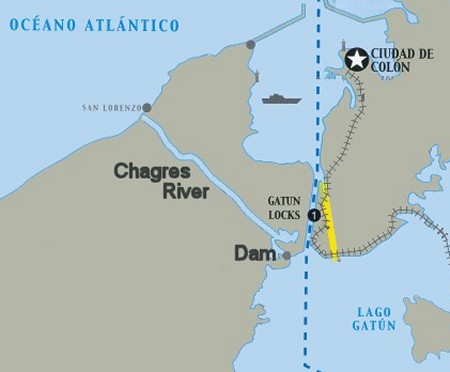 |
On the left, we entered Lock One.
On the right, they brought the waters in Lock Two up to our level.
Once the water was
level, we sailed forward into Lock Two. Once we were
settled in Lock Two, they let the water out and our ship sank
30 feet right on the spot.
Sorry to say, but the
Gatun Locks were anti-climactic.
They let us sink 30 feet
in three different locks till we had descended 85 feet. Now we were ready to go out to sea.
It was so smooth it was easy to overlook the ingenuity involved.
Over in the distance I
could see a long, narrow brown hill. That hill obviously had
something to do with the construction of the new locks depicted by
the yellow stripe on the map.
I assumed the dirt mound was created by excavation
for the new locks.
The longer, wider ships
of our modern era will be able to use these locks in 2015.
|
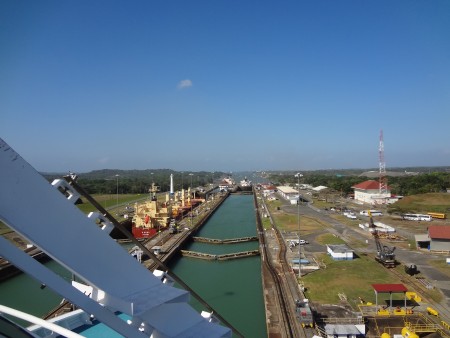
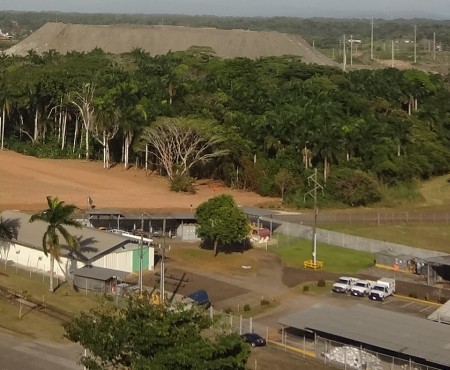 |
The Panama Canal expansion means a welcome potential boost for
Houston
|
Rick's
Note: I was unaware of the importance when we visited the Panama, but I
later realized the expansion of the Panama Canal promises big business
for Houston. There is a lot of talk about a Hong Kong -
Houston linkup not too far in the foreseeable future.
HOUSTON CHRONICLE
Sunday, June 26, 2011
Those visionaries who dug the Houston Ship Channel a century
or so ago must be smiling down as they consider the bright prospects
directly ahead for their ruggedly hewn handiwork.
Our region's major trade and commerce engine will one day
add several cylinders of economic power to Houston thanks to the
expansion of the Panama Canal scheduled to be completed in 2015.
The historic canal, which opened up trans-Pacific trade to
the Gulf of Mexico and Atlantic ports a century
ago, is being broadened and deepened to accommodate container ships
that are much larger than the current models.
How much larger?
According to Chronicle Business reporter Jenalia Moreno, the ships that can fit through the canal today carry
about 5,000 twenty-foot-equivalent units, or TEUs, the familiar
containers that fit on rail cars or attach to 18-wheeler trucks.
Following the expansion, the new megaships will transit loads of
about 12,000 TEUs and, in some cases, up to 18,000 TEUs. (The latter
will only operate in Asian ports such as Hong Kong with cranes large
enough to reach across the megaships' girth to handle the
containers.)
Many of these supersized vessels will be headed towards Houston,
necessitating expansion of the Barbours Cut terminal in LaPorte.
As Greater Houston Partnership CEO Jeff Moseley said, this is
a "game changer" for the Port of Houston, which, as Moseley noted,
sits at the geographic epicenter of the change.
A good many of those
oversized vessels will be off-loading and on-loading cargo at the
Port of Houston facilities.
Port of Houston officials and
others are downplaying the expectation that the
expansion of the Panama Canal will actually double the container
traffic transiting the Port of Houston. If these estimates prove to
be overly optimistic, there's no denying it
will still result in a major uptick in activity.
Houston's geographic position as the first major US port for any
ship departing the eastern side of the Canal gives it quite an
unusual advantage. With the protection of Galveston Bay
assuring the safety of the container vessels and its vast network of
railroads and highways, Houston is positioned to relay off-loaded
goods quickly to the heartland of the US.
There are already signs of a Panama ripple effect.
Indeed, the "ripple effect" is detectable across our region as major
retailers such as Home Depot and Walmart have begun to build
distribution centers across the area.
Informed observers say this trend figures to continue as smaller
retailers follow in the footsteps of the giants. That is good
news for the port and the greater Houston region.
It reminds us once again of the port's huge impact on our economy.
It also should remind those in charge of the port of the urgent
necessity of full transparency and responsible stewardship of this
invaluable resource.
We suspect the visionaries who built the Ship Channel are paying
attention to that too.
We certainly are.
|
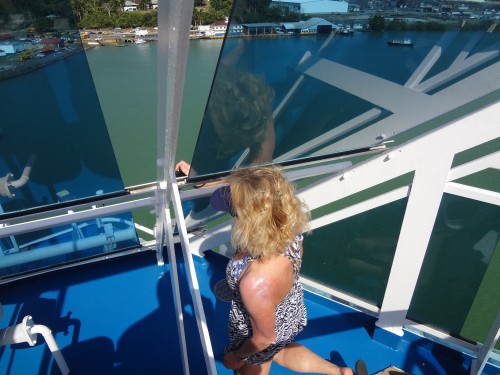
Cindy is back. What is she photographing
this time?
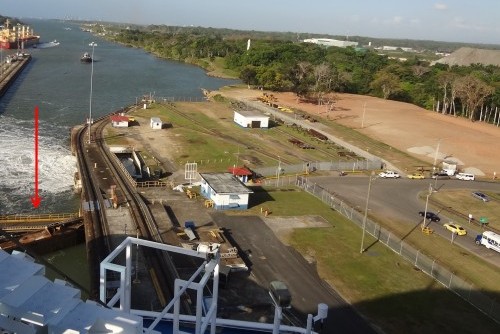
Do you see those cars below? They
are waiting for
something.
Jean our narrator
just announced the
existence of a hidden roadway beneath the final lock.
Cindy got curious and came back to take some pictures.
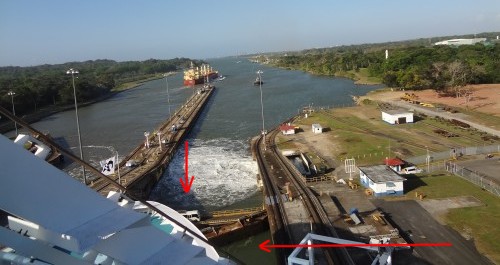
There are 3 things
to notice. First, notice how high the
water is in our LOCK. Second, notice the water flurry.
That flurry is caused by water leaving our LOCK.
Third, note the white vehicle using the hidden roadway. |
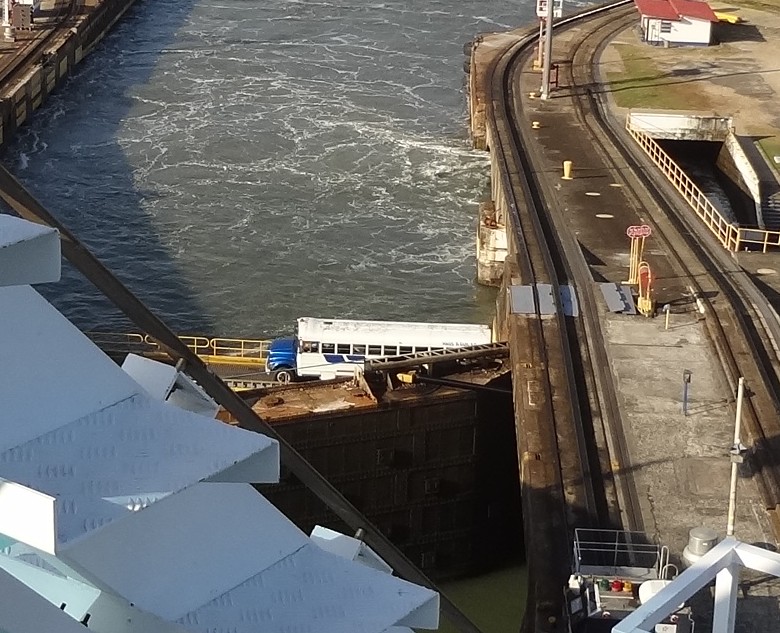 |
In this final caption,
you can better see the hidden roadway. Apparently the hidden
roadway is not a permanent structure.
It is a temporary bridge
that acts like a drawbridge in that it only operates periodically.
While our ship is busy sinking, the cars take advantage and cross.
It is an arrangement similar to waiting for a ferry.
I believe the bridge operates
like a tongue... there is a section on each side. Both
sections are hidden under the cement. When it is time, the
"tongues" extend outward. Once the tongues meet in the
middle, then the cars roll
across.
In the absence of a
permanent bridge, the cars would rather wait than make a 100 mile
roundtrip to other other side of Panama to use the Centennial
Bridge.
Note that the water level
in the LOCK is now at sea level. As soon as the last car is
through, the tongues will retract, the gates will open, and our
ship will be allowed to enter the Caribbean Sea.
We are nearing the end
of the Panama Canal experience.
|
As the picture on the right shows, we are free at last. It
is now 5 PM. If you remember, I got
out here at 5 AM. I have just put in twelve consecutive hours
watching our ship transit the Canal. Considering we didn't get
started till 7 am, it took 10 hours in all for the ship to cross the
Canal.
No one seemed to care
about this final stage of the trip. I was practically the only person left on the front deck
of the ship. I didn't expect any medals, but I will say that if they
handed one out for endurance, I would have won hands down.
My only real
disappointment of the day was the molasses nature of the locks. I never
realized how slow the locks were. Plus I suspect I was too
tired to have patience here at the end. Guess what? Now
I'm pooped. It's time for a long nap.
Although the day didn't start very well,
seeing the smile on Polly's face when she discovered her reserved
seat plus seeing the Queen Elizabeth
definitely made up for all the early dawn nonsense. Plus I
learned a lesson - if you want to save a chair, bring extra chairs
for the others.
|
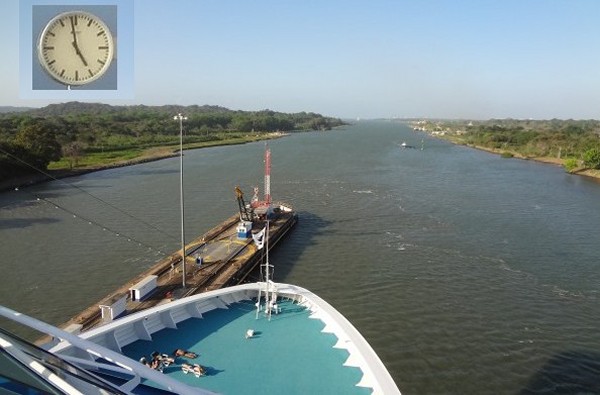 |
I particularly enjoyed
seeing the Culebra Cut, the Chagres - Canal junction, Lake Gatun and
the Gatun Dam. It gave me a real appreciation for the
magnitude of the accomplishment.
To me, this accomplishment is just as magnificent
as the Pyramids of Egypt. Like the Pyramids,
the Canal project was far larger than the technology that was available at the
time.
At the time of the
French involvement, France was one of Europe's leaders in science
and engineering. For that matter, the French had done a
magnificent job building the Suez Canal just prior to starting this
project.
Nonetheless, the French
never even came close, a defeat underscored by a
staggering amount of suffering on the part of the workers and the
astounding 50% mortality rate.
The fact that a great nation like France couldn't pull it off makes
the eventual American success even more remarkable.
|
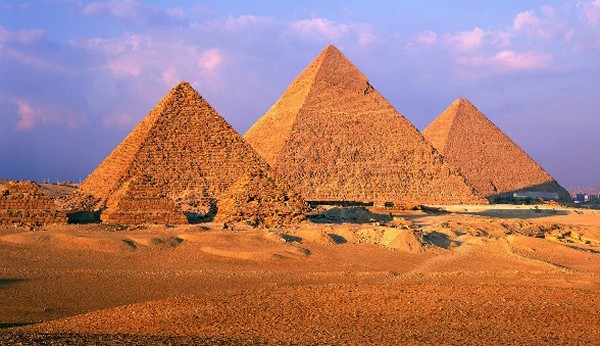 |
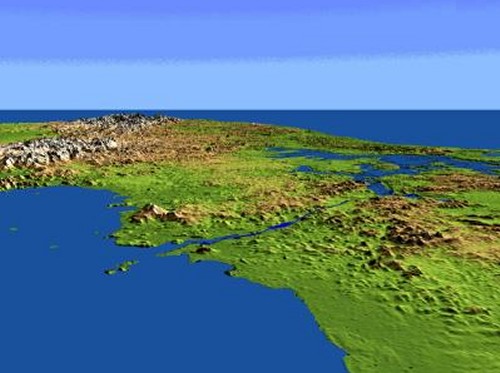 |
It took amazing
perseverance and incredible ingenuity on the part of the Americans to solve
the same obstacles facing the building of the Panama Canal that had
defeated the French.
Why the Canal is not
listed as one of the 7 New Wonders of the World is an omission that
leaves me completely baffled.
The one thing I am sure
of is that the existence of the Panama Canal is a modern marvel that
makes me proud of the Americans who saw this project through to its
finish despite the incredible odds against it.
I respect tremendously
the American military courage shown in battles like Iwo Jima and
Omaha Beach, but that's a different kind of accomplishment.
To me, scientific
breakthroughs like
putting a man on the moon and building this amazing channel is what
makes me really proud of America. These achievements are the
perfect synthesis of brain, brawn and willpower.
It shows me what America
is capable of when it really puts its mind to it.
|
| |
|
|
| |
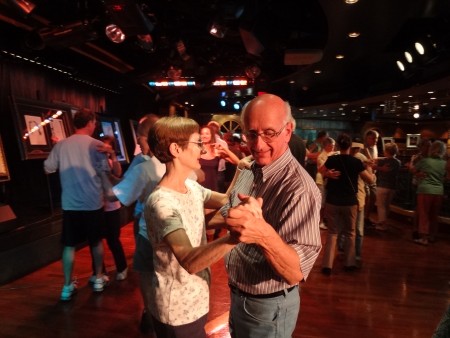

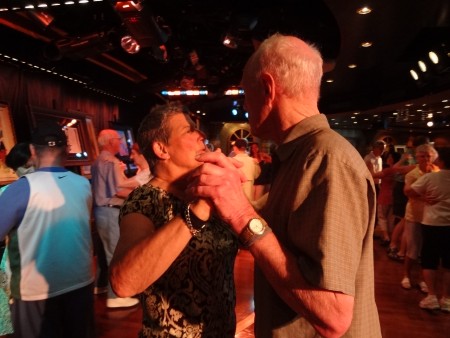
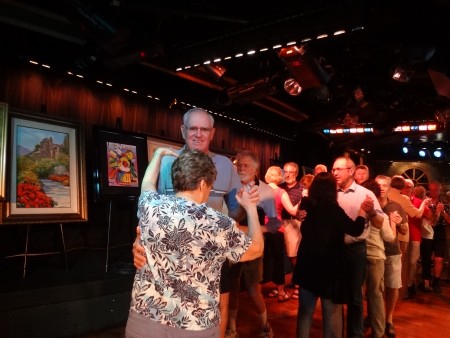
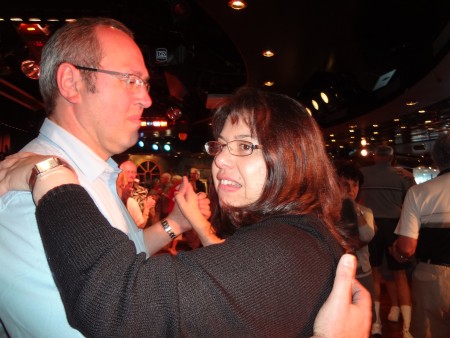
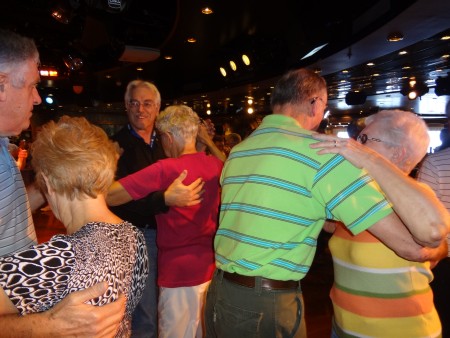
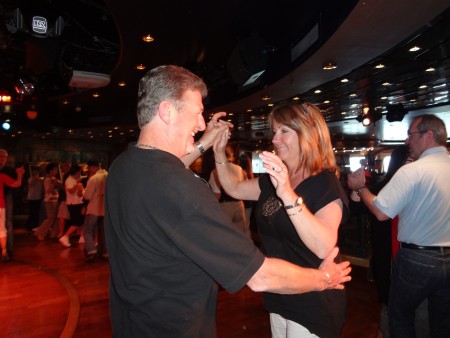

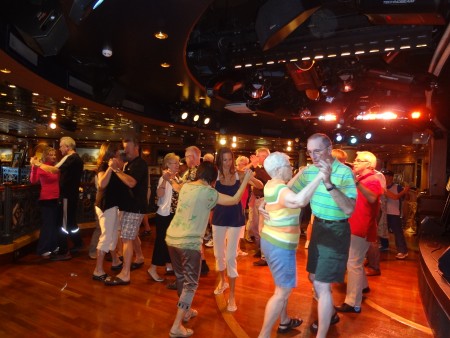
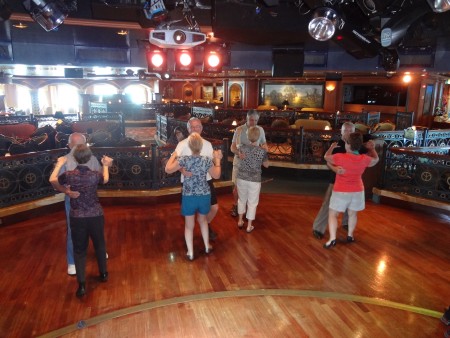
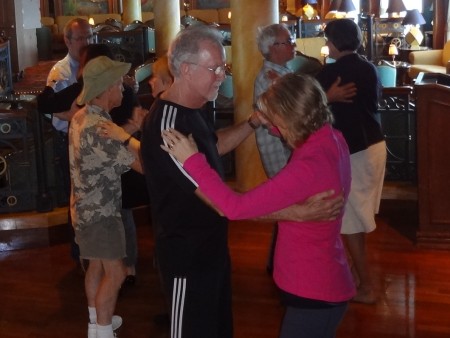 |
Dance Class
One morning on my way back to the
Hovel, I crossed paths with JJ, the ship's cruise director.
JJ is the person who
schedules the activities. I had not met him previously, but after I
introduced myself, he patiently listened to my requests.
I explained to JJ that
our classes had been popular so far on the trip.
With that in mind, would
he consider letting us have an extra dance class in Aruba?
After all, we did not
dock there till 1 pm. Why not have a
class in the
morning?
JJ smiled and said that
was a good idea.
Next I told him our
students had approached me about a review class where we could go
over all the material from 2 weeks of classes.
Would it possible to dance for two hours on the final day?
Again JJ nodded and said
that would work. Anything else?
Well, actually, yes.
Chris, the band leader, had spoken about having another Big Band
Night.
Would JJ be able to schedule that dance event as well?
JJ nodded and said I
could
consider it done.
I was greatly
encouraged. This would greatly support dance class for the
final four days of the trip.
The Aruba dance class
worked out just fine. I had a neat lesson plan that showed how
the same pattern could be used to Night Club, Rumba, and Salsa.
This was definitely our best dance class of the two-week period.
The only quirk was the
red lighting supplied for our dance lesson. Combined with some
unusual nudes among the art displayed, I overheard
several wry
comments about dancing in a bordello. I wouldn't know.
As good as the Aruba
class had been, I was extremely disappointed when my class fell
apart the following day.
To begin with, I didn't
feel well. I was coming down with a cold. So that cost
me my sense of humor, always my best asset when things don't go
right.
I had intended to teach
a follow-up class to my previous class. I would review the
pattern, then show everyone an advanced option to extend it.
At this point I had ten
excellent couples, all of whom appear in these red light pictures.
I geared my lesson plan for them.
My downfall came when
several couples attended who had not been with us the day before.
The moment I began to teach the advanced material, several people
struggled.
I watched in dismay as several people walked out. I realized I had reached
too far. I believe my ten couples could have handled the
material, but I wasted so much time trying to catch the newcomers up
that the lesson turned out to be a waste
of time.
Adding to my misery,
immediately after class I learned that JJ had just left the ship in
Aruba. Whoever they put in charge refused to honor his
agreements.
Not only was my final
class reduced from two hours to 45 minutes, the Big Band Dance Party
was canceled as well. I felt just like Charlie Brown after
Lucy has pulled the football away.
I had
counted on that
Dance Party to reward my students for all their hard work. But
that fantasy was sent packing down the drain.
I gamely tried to help
my students with the difficult pattern after class, but my lack of
energy due to the illness was apparent. My friends Sandie and
Dave (pictured left) were practically the only ones who got it.
Down in the dumps, I went back to the Hovel to be alone with my cold
and failed lesson plan.
I had learned
a lesson the hard way. It had been a mistake to teach a
difficult move. I wasn't given enough time, my class was far
too large, and I had no way to prevent newcomers from joining the
class.
I should have taught a
beginning pattern to a new dance and left it at that.
I decided that in the
future the only way I could teach advanced patterns on a cruise ship
would be to have a private class.
On our final day, I
decided I would work around our 45 minute limitations. I
taught a well-received course in the basics of Slow Dancing.
Afterward I offered to
let people videotape Marla and I dancing in a different room.
My regulars were very pleased at this chance.
The Gypsy Dance Class
followed us to another room where I spent half an hour going over
the various patterns and answering questions. They were so
appreciative. The dance classes were definitely the true
highlight of my trip.
The friendships we
developed over the two-week period were very special. I only
wish there had been more built-in chances to practice what we
learned as a group during the evening hours.
It was a real blow to
see that final Big Band Dance Night canceled.
I think that would have
been the perfect touch to finish off our two weeks of dance class.
|
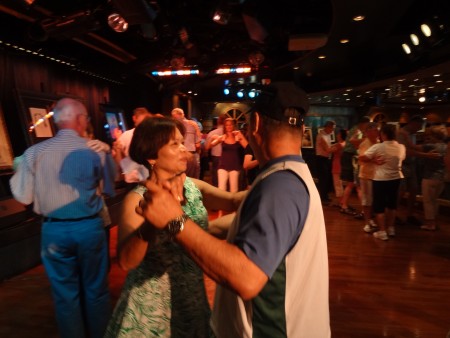
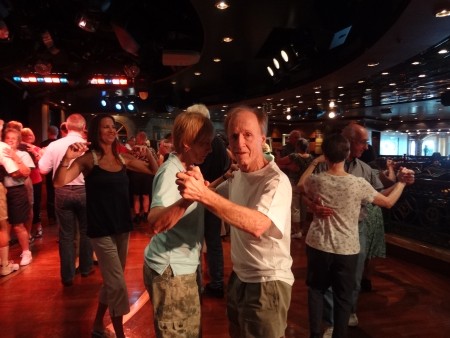


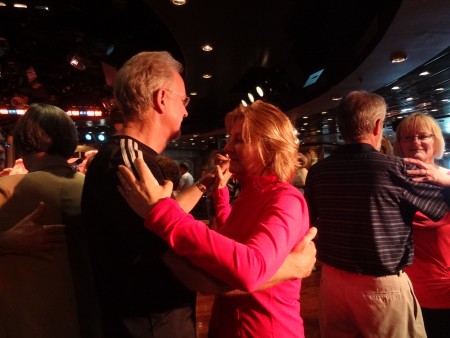
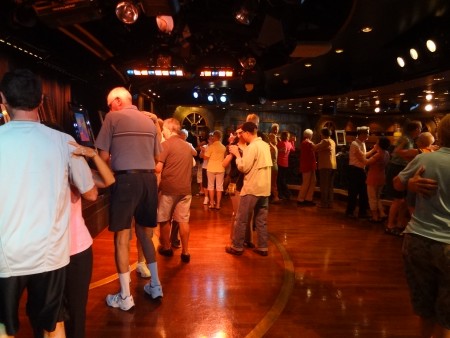
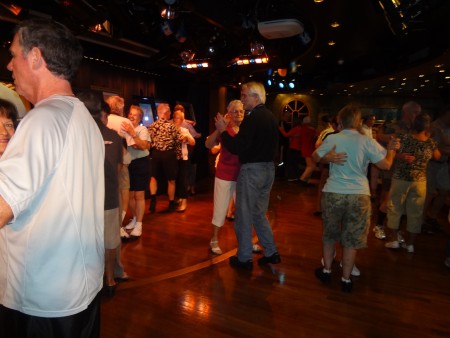
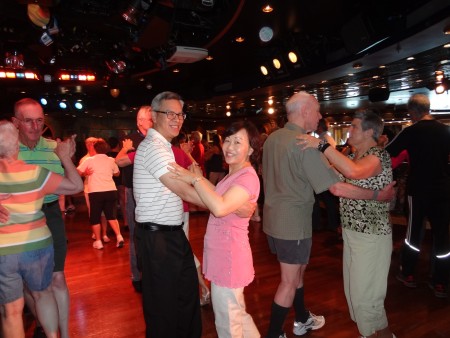
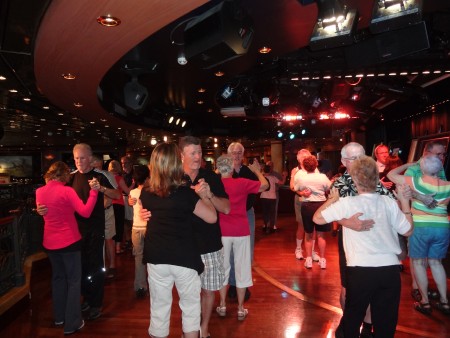
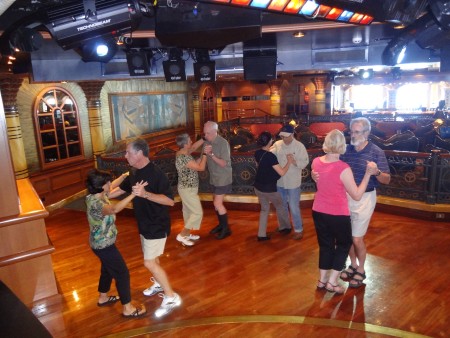
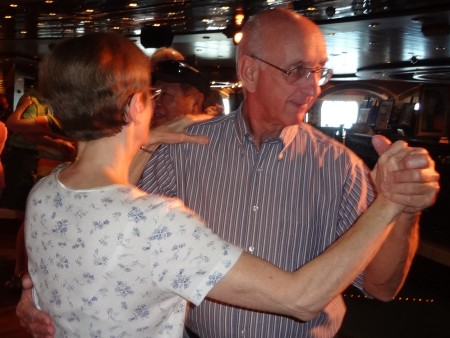 |
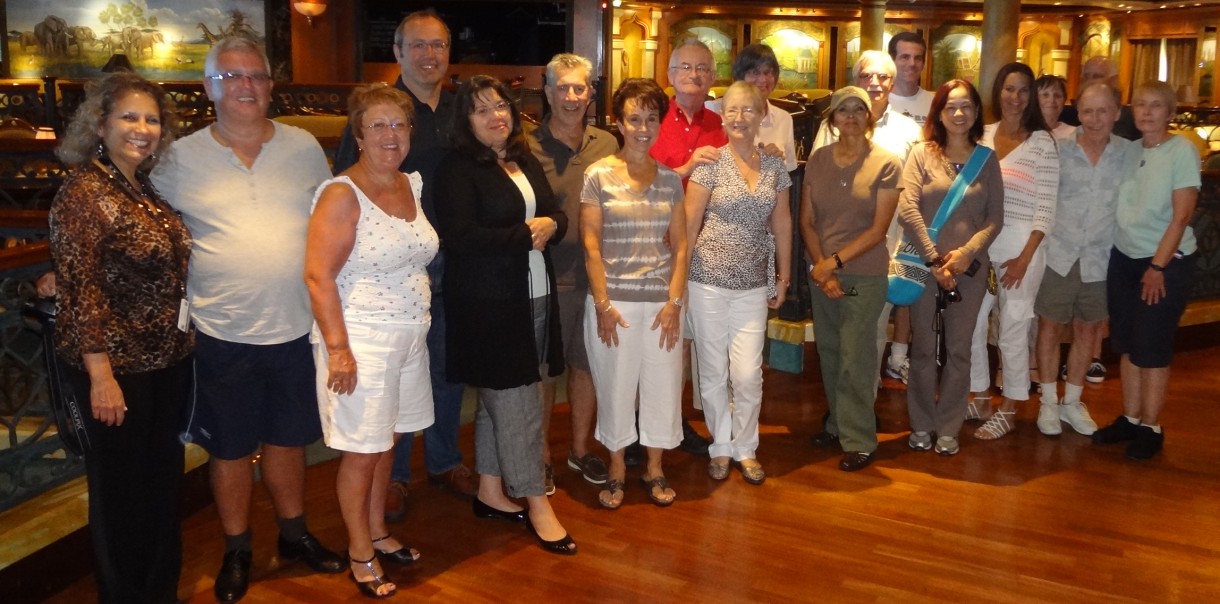
Parting
Thoughts
|
Marla and I thoroughly
enjoyed teaching our classes on the ship. However, as I flew
home, deep down I was troubled by the fact that most of what I did
was a lot closer to entertainment than the actual teaching of social
dance.
Don't get me wrong - I
enjoyed teaching the large group Beginner classes. But,
speaking candidly, very little of that material ever "sticks".
The beginning moves are soon forgotten because the ships furnish so
few opportunities to practice. I predict the same people will attend
Beginner Dance classes on the next cruise and have no choice but
cover the same Box Steps and Back Steps as this trip.
I am convinced there are
passengers who would love to use a cruise trip to actually improve
their skills at dance. What could be a finer use of free time?
My dream was to take a
group of students the first day at sea and train them for an hour
every day of the trip in one specific type of dance music (Latin,
Swing, Western, Waltz, Foxtrot, Rumba). I would let the students
choose.
Then on the final night
of the cruise, the ship could schedule a special dance party
along the lines of the Big Band Night we had on this trip.
In particular, the Band would play an extra number of
songs we could practice our dance specialty to. The promise of
this reward would be a great incentive to motivate the
students. They would get a chance to see their hard work pay off
during an evening of fun.
No one will admit it,
but the biggest obstacle is the fact that dance classes are not a
source of revenue. It goes without saying the Bingo beats
Ballroom every time. So why not charge for it? That
would be a game changer.
Offer free classes and
offer higher level classes at a different time for a fee. I noticed in the gym
that they had intensive exercise programs that people could sign up
for. These programs were reasonably priced and targeted only
the most highly motivated passengers. So why not offer dance
classes for an extra fee?
|
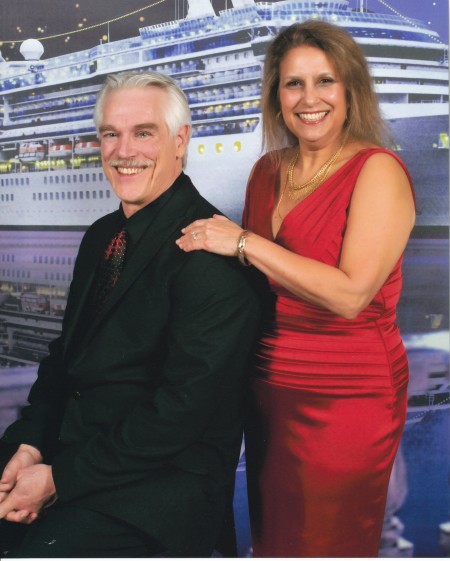 |
I know the interest is
there.
My group of ten couples would have jumped at the
opportunity and probably others would have as well. Based on the
comments of the people I talked to, they would have loved to take an
ongoing dance class that would have challenged them.
The only question is
whether a ship or a cruise line would give my ambitious project a
try.
Well, here's the way I look at it. A recent change in the
cruise industry is the addition of the specialty restaurants.
They hint that you will get a fine dining experience in the main
dining room at no added expense, but you can also get a "finer"
dining experience at the Italian restaurant or the steakhouse.
Why not try the same
concept with dance class?
On the first day of the
trip, I could teach beginning patterns in the morning at no charge.
I would use that opportunity
to let people know they were welcome to
participate in an intermediate class at a
different time later the same day at no charge. If they liked
the first class, then they could sign up for the package at that
time. For the rest of the trip, I would
continue to teach daily beginner classes for free and conduct
special dance classes at another time for a fee.
If it works for exercise
and restaurants, why wouldn't it work for dance? People have
free time and are looking for a challenge.
I imagine if I talked to
the right person, they would listen. The people who run the
cruise lines understand a good idea. The thought of offering
additional free dance lessons would probably cause
a yawn, but dance classes for a fee might get their attention. They
are always looking for a new source of revenue. If anyone in
the cruise industry would like to sit down and discuss it, send me
an email.
|
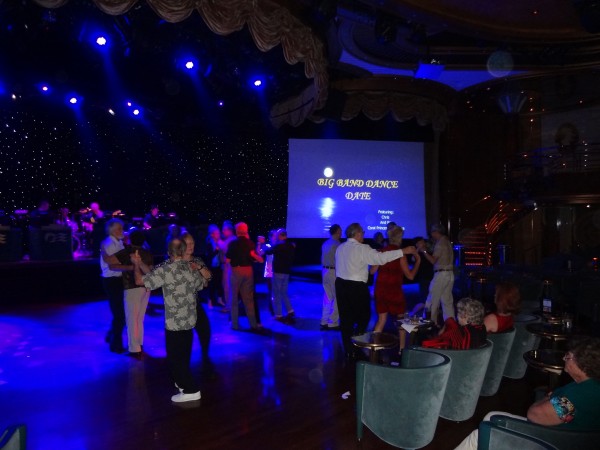 |
A
Dance Camp program would accomplish two very valuable
things.
First of all, only
students who were serious about learning to dance would sign up.
This would keep the class small and allow me to personally supervise
each
student's progress.
Second, once dance classes became a source
of income, then more attention would be given to the dance classes.
Instead of getting dumped for extra bingo events, maybe the would
schedule a terrific "Graduation Dance Party".
If anyone wants to
actually improve their dance skills at sea, the pay-extra Dance
Camp idea is probably the best bet.
Perhaps someday I will get my wish and be allowed to implement my
"Learn to Dance at Sea" program. Hopefully my program will
also include evening activities such as the Big Band Dance Night in
the picture.
Thanks for reading my
story. I hope you enjoyed it!
Rick Archer
February 2012
rick@ssqq.com
|
|
Letters to the Editor
LETTER ONE
Hi Rick
Thank you for your account of the trip. A friend of
mine found your story and forwarded me the link.
We took some of your dance classes and
really enjoyed them.
Unfortunately we were very frustrated by
the ever changing times. We were also signed up for
another activity. Several times both your class and the
other activity were put in the same slot. We were forced to
choose and we didn't want to... we wanted to do both!
Plus the time for our other activity
kept changing too. I put in comments to Princess about needing to
know what would clash at the beginning of the cruise so
people could make informed decisions.
We live out in the country and it is a long way to the
nearest dance class after work. We have tried taking
lessons but in the winter things just get in the way.
And the classes don't run in the summer because no one
attends - probably harvesting!
So we would be keen on some scheduled
intensive dance classes on a cruise as I read about in your
story.
Anyway, thanks for the classes and the 'story'. S.
Rick's Note:
I agree. No attempt
was made to coordinate the dance classes; they were just
shoved in a corner.
You also pointed out that visiting a dance studio is
difficult due to where you live, but that a cruise would be
the ideal time to take lessons. If you had to pay a
little extra, more than likely whatever you paid on a cruise
would be less than what you would pay at dance studio, so
why not put your time to good use?
LETTER
TWO
Hi
Rick and Marla,
Really enjoyed you Panama Canal Story and photos. You
are a very good and entertaining writer. My husband
loved all the maps and charts about the canal. Princess
seemed to be especially "map challenged", even regarding
the ports. When I suggested to the Tour Desk that they
provide more/better maps (like other cruise lines) they
told me that maps had to be approved by CORPORATE and
that it was too difficult to make changes/improvements!!
We
loved your dance classes, it got us inspired to start
dancing again regularly. We met at a West Coast Swing
Workshop 16 years ago and prior to that we both took
lots of classes, workshops, dance cruises, weekend
workshops, etc.
Then we got married and moved to an area with less
classes/dances available and only danced on cruises for
the next 8 years, then we got away from cruising for 7
years and stopped dancing altogether. We would
definitely have been willing to pay additional to take
Intermediate/Advanced Classes on the ship. We really
liked your emphasis on style/technique and how you
pointed out that the various patterns could be used in
numerous dances. It's amazing that you made such
progress considering the large classes, various levels,
and short amount of time. The classes were also fun.
Hopefully we can go on one of your dance cruises in the
future. H
Rick's Note:
Thank you for the kind
words. Tell your husband I love maps too!!
Especially when writing about adventures, I find maps do a
wonderful job of helping people less familiar with the
location to keep track of things.
We
would definitely have been willing to pay additional to
take Intermediate/Advanced Classes on the ship.
You are the
second person to write and agree the "pay for Intermediate
dance lessons" is a good idea. Maybe I can contact
someone in the industry and make the suggestion.
People love to dance on cruises. And, truth be told, I
think the cruise lines understand that having lots of people
dance is good for business. Their problem is that the
general population doesn't dance, so they have gotten tired
of pushing random dance events where they have to pull teeth
to get people to participate.
I don't it has
ever occurred to them to simply train people to dance on the
cruise trip as a way to promote an evening dance event.
LETTER
THREE
I
was rolling in floor laughing so hard while reading your
Panama cruise story about your accommodations. I know it
wasn't funny at the time and hope you can now laugh
about it. Your upcoming trip on The Titanic
Anniversary Voyage should help heal your pain nicely.
I
know what you mean about regular cruisers not dancing on
cruises. Many times Bette and I are the only ones on the
dance floor. Once a lady left her group and walked over
and asked if I would dance with her. Since Bette had
been dancing with the two dance hosts, she didn't have a
problem with me dancing with the stranger. Turns out she
was from San Antonio and here we were in the middle of
the Mediterranean. Small world.
For us dancing is the best part of a cruise and we
interact with the dance hosts a lot. Teaching dance on a
cruise sounds like so much fun. Larry
Rick's Note:
Teaching dance on a cruise
is indeed wonderful fun. I will get back to you when
we start laughing about sleeping on the bunk bed.
LETTER FOUR
I
read your story about Costa Rica. I agree this is
a lovely place. And the locals, "Ticos", are so friendly
as well.
I
was there in June, 2001. I remember our drive from the
airport in San Juan to the other side of the coast - to
Guanacasta. On the way, we stopped at a little dinner to
grab a bite and a beer, and when we went in, there were
some locals hanging out. The music was playing, and the
next thing I knew, I was dancing with a Tico. What fun.
Seeing Mt. Arenal, the volcano, was and remains my most
favorite memory of any trip (followed closely by the
Hubbard Glacier). I watched it spit and dribble lava at
night - from the road, from our table at the restaurant
while dining, from a hot tub at my hotel, and then, from
bed. I needed to only turn my head to one side to watch
the lava trickle down the side. It was AMAZING. The next
day, we were horseback riding when we heard it rumble.
At that point, I was ready to get a bit further from the
volcano. After all, two people had died there just a few
years earlier.
After leaving there, we went to the hot springs at
Tabacon, which are located near Arenal and heated
thermally. An absolutely glorious place, and the water
was like a pleasant bath. So delightful. Of course, the
roads leading to and from the area were the worst that I
have ever encountered in any of my travels ever!
At the end of this trip came one more surprise.
Tropical Storm Allison had just hit Houston. We were at
our bed and breakfast back in San Juan and preparing to
leave the next morning. Our host asked me if I was also
from Dallas (as my friend was), and I told him I was
from Houston. That is when he said, "Oh my! That has
been declared a state of emergency." Of course, I had no
idea what he was talking about. My friend and I were
traveling with two sixteen-year old boys, so we never
had custody of the TV, so I had no idea that Tropical
Storm Allison was playing havoc with Houston. Of course,
I couldn't fly back in. They offered to send me to
Dallas and then to Houston, but I thought staying in
Costa Rica might be more fun. Of course, I didn't
realize that everything shuts down on Sunday, because
the day is devoted to family event. No stores were open,
nothing to do at all.
So I went to a park and tried to call home repeatedly,
but couldn't reach anyone because the phone lines were
out. I have to admit, I wished I had gone on to Dallas.
At least there I could have gotten more information than
the same 5 minute clips that were on CNN Headline news.
The next day, I was able to get back to Houston.
Although it was Sunday morning (about noon, actually)
you could barely see evidence of water anywhere! Of
course, a number of the townhomes in my subdivision had
water in them up to about 18 inches or more. I was
fortunate. My home was one of a very few that had no
water in it at all. That did give it an ace up for a
selling point, later - NEVER FLOODED. Not that many
homes in my area could say that.
When I got home, my friends told about the floods, and
people stranded and staying overnight at the studio.
No matter where you were, that was some week to
remember. Judy
|
|